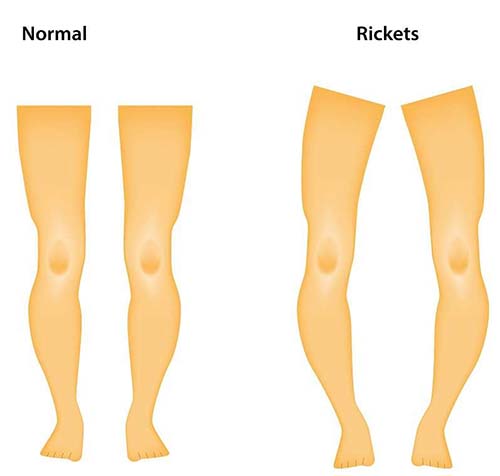Today, we will discuss rickets, a condition that has garnered significant concern among people worldwide. Many individuals, particularly parents and caregivers, are worried about its impact on children’s growth and overall health. In this article, we will explore what rickets are, why they raise so much concern, and the factors contributing to their prevalence. Additionally, we will delve into preventive measures that can help safeguard the growth and well-being of our children.
What are rickets?
Rickets are a medical condition that primarily affects children and is characterized by the softening and weakening of bones. It is caused by a deficiency in vitamin D, calcium, or phosphate, essential nutrients required for proper bone development and mineralization. Without adequate levels of these nutrients, the body cannot effectively deposit minerals, like calcium and phosphorus, into the growing bones, leading to their improper formation and weakening.

Causes of Rickets
- Vitamin D Deficiency: The most common cause of rickets is a deficiency in vitamin D. Vitamin D plays a crucial role in calcium absorption, which is essential for bone health. Lack of sufficient vitamin D can lead to impaired mineralization of bones, resulting in weakened and soft bones characteristic of rickets.
- Inadequate Sun Exposure: Sunlight is a natural source of vitamin D. When the skin is exposed to sunlight, it synthesizes vitamin D, which is then utilized by the body. Insufficient sun exposure, especially in regions with limited sunlight or during the winter months, can contribute to vitamin D deficiency and increase the risk of rickets.
- Poor Dietary Intake: Rickets can also occur in individuals who have diets lacking in vitamin D and other essential nutrients, such as calcium and phosphorus. A diet devoid of these vital nutrients can hinder proper bone development and increase the susceptibility to rickets.
- Malabsorption Issues: Certain medical conditions or gastrointestinal disorders can impair the absorption of nutrients, including vitamin D, from the diet. Malabsorption can lead to deficiencies and subsequently increase the risk of developing rickets.
- Breastfeeding without Vitamin D Supplementation: Breast milk is a valuable source of nutrition for infants. However, breast milk alone may not provide sufficient vitamin D to meet a growing child’s needs. If breastfeeding infants are not adequately supplemented with vitamin D, they may be at risk of developing rickets.
- Genetic Factors: While vitamin D deficiency is the primary cause of rickets, genetic factors can also play a role. Some individuals may have genetic conditions that affect their body’s ability to absorb or utilize vitamin D, making them more susceptible to rickets.
- Premature Birth: Premature infants have higher nutritional requirements to support their growth and development. If these nutritional needs are not met, it can increase the risk of rickets and other health complications.
- Certain Medications: Some medications can interfere with the body’s ability to process or utilize vitamin D, leading to deficiencies and potentially contributing to rickets.
- Geographical Location: The prevalence of rickets can vary depending on the geographical location. Regions with limited sunlight or where vitamin D-rich foods are scarce may have a higher incidence of rickets.
- Ethnicity and Skin Pigmentation: Individuals with darker skin pigmentation have higher levels of melanin, which can reduce the skin’s ability to synthesize vitamin D from sunlight. This higher melanin content can increase the risk of vitamin D deficiency and rickets in some populations.
What are the common symptoms and signs of rickets in children?
The common symptoms and signs of rickets in children may include:
Bone pain or tenderness
Children with rickets may experience discomfort in their bones, especially in the wrists, ankles, knees, and ribs.
Delayed growth
Rickets can lead to stunted growth or a delay in a child’s overall growth and development.
Bowing of legs
Weight-bearing bones, such as the legs, can bend outward or become bowed due to weakened bones.
Bumps in the ribcage
Rickets may cause abnormalities in the chest, leading to noticeable lumps or bumps in the ribcage.
Soft or weak bones
Affected bones may feel softer than normal and can be more prone to fractures.
Dental problems
Rickets can lead to dental issues, such as delayed tooth development and an increased risk of cavities.
Muscle weakness
Children with rickets may experience muscle weakness, impacting their ability to perform certain physical activities.
Delayed motor milestones
The condition might cause delays in achieving certain developmental milestones, such as sitting up or walking.
Craniotabes
In some cases, the soft spots on an infant’s skull (fontanelles) may feel larger and softer than usual.
Irritability and general fatigue
Rickets can lead to irritability and fatigue in affected children.
Does having rickets affect a child’s height?
Unfortunately, it can. Due to a lack of vitamin D, calcium, or phosphate, rickets affect bone growth and mineralization. As a result, children with rickets may experience stunted growth or delayed growth milestones. The softening and weakening of bones can cause skeletal deformities, such as bowed legs, an abnormal curvature of the spine, and other bone abnormalities.
Early detection and proper treatment of rickets are essential to supporting healthy bone growth and minimizing the long-term effects on a child’s stature. Providing sufficient vitamin D, calcium, and phosphate through appropriate dietary intake, supplementation, and exposure to sunlight can help prevent and manage rickets, contributing to better growth and overall well-being in affected children.

How can I prevent rickets in my children?
Making sure kids get enough vitamin D, calcium, and phosphorus for proper bone development is essential to preventing rickets in their growing years. Here are some essential steps:
Adequate sunlight exposure:
Sunlight is a natural source of vitamin D. Encourage your children to spend some time outdoors in sunlight each day, particularly in the early morning or late afternoon when the sun’s rays are less intense. Exposing their face, arms, and legs to sunlight can help the skin produce vitamin D.
A balanced diet
Ensure that your child’s diet includes foods rich in vitamin D, calcium, and phosphorus. Good sources of vitamin D include fatty fish (e.g., salmon, mackerel), fortified dairy products (e.g., milk, yogurt), and fortified cereals. Calcium-rich foods include dairy products, leafy greens, and fortified plant-based milk. Phosphorus can be found in foods, like meat, fish, nuts, and whole grains.
Vitamin D supplements
In some cases, children may not get enough vitamin D from sunlight and diet alone. If recommended by a healthcare professional, vitamin D supplements can help meet their daily requirements. Always consult with a doctor before giving any supplements to children.
Breastfeeding or formula feeding
For infants, breast milk is a valuable source of nutrition, including vitamin D. If breastfeeding exclusively, consult with a pediatrician about vitamin D supplementation for the baby. For formula-fed infants, make sure to use a formula that is fortified with vitamin D.
Regular check-ups
Regular visits to a pediatrician allow for monitoring your child’s growth and development, including assessing their bone health and risk factors for rickets.
Limit sunscreen use
While it’s essential to protect your child’s skin from harmful UV rays, excessive use of sunscreen can inhibit vitamin D synthesis. Allow some sun exposure before applying sunscreen or during times when sun protection is not as critical (e.g., early morning or late afternoon).
Exercise and physical activity
Encourage regular physical activity and exercise, as they support bone development and overall health. Here’s a list of exercises that can help promote bone health:
- Jumping exercises, such as jumping jacks, skipping rope, and jumping on a trampoline, help stimulate bone growth and increase bone density.
- Running and jogging are weight-bearing activities that put stress on the bones, which can strengthen them over time.
- Dancing, especially activities that involve jumping and twisting movements, is a fun way to promote bone health while improving coordination and balance.
- Hopping on one foot or doing hopping drills can also be beneficial for bone development.
- Many sports involve weight-bearing movements and can contribute to bone health. Sports, like soccer, basketball, tennis, and gymnastics, are excellent choices.
In conclusion,
The impact of rickets on a child’s height is a significant concern that cannot be overlooked. Rickets, stemming from vitamin D deficiency, disrupt the essential processes of bone mineralization during crucial growth stages, potentially leading to stunted growth and skeletal deformities. As we have explored the intricate connection between rickets and a child’s height, it is evident that early detection, prevention, and timely treatment are essential to mitigating the long-term effects on their overall development. By ensuring adequate vitamin D intake, regular exposure to sunlight, and prompt medical intervention, parents, caregivers, and healthcare providers can play a vital role in safeguarding the growth and well-being of our young ones. Embracing a proactive approach and spreading awareness about rickets is the key to empowering future generations to reach their full physical potential and explore the wonders of the world with confidence.



